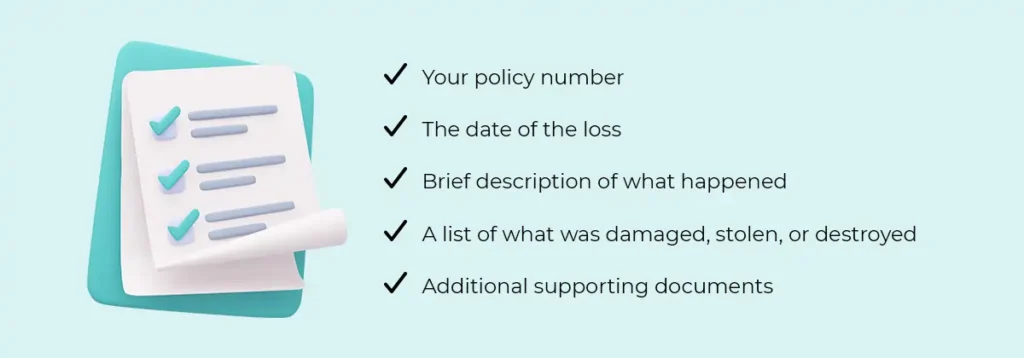If you were to get into an accident, say a fender bender, and your car sustained damages for which you wanted to be reimbursed, you’d need to file a claim. Pretty standard, right?
A key part of the claims process is filling out a form called “proof of loss.” Virtually all insurance companies require this form when you submit a claim, as it helps show the value of what was damaged. The insurance claims process can be confusing, so let’s break down the proof of loss form a bit more thoroughly.
What is a proof of loss form?
A proof of loss form is a formal document that must be signed and submitted as part of the claims process. It usually includes evidence of the damage; i.e: photos, estimated value of what was damaged etc.. Some companies will also require a police report for your claim, depending on the nature of the damage or loss.
In insurance, it’s the policyholder’s responsibility to explain and prove their loss. To improve your chances of a successful claim, provide as much evidence as possible and fill out your proof of loss form as best and as diligently as you can.
A proof of loss form is considered a legally binding document. Once it’s submitted, it becomes a notarized, sworn statement of the damages that you’re trying to claim.
Proof of loss forms are quite common, especially if the claim value is higher than average or if the cause of damage is suspicious.
What is included in a proof of loss form?

A proof of loss form will usually ask for the following information:
- Your policy number (you can ask your broker for this, or find it on your policy documents. Some insurance companies also have apps where you can find this.)
- The date of the loss, as well as a brief description of what happened.
- A list of what was damaged, stolen, or destroyed.
- Additional supporting documents, such as proof of purchase (receipts, warranties), photos of the damage, and police reports (if applicable).
Gathering all of this – especially at a stressful time – can be overwhelming, but luckily, your insurance broker and the adjuster assigned to your case will help you through.
Proof of loss forms don’t vary much between insurance companies, so don’t worry about having to go through a different process if you’ve switched providers recently.
How do you file a proof of loss form?
Your policy will outline what information is needed in a proof of loss form. Ask your insurer for information on how to access a form. When filling it out, again, remember accuracy is key to avoid fraud or misrepresentation.
Keep in mind that there are three things you’ll need to be aware of when filling out a form:
Ensure that all information in the form is truthful
Filling out your proof of loss form inaccurately or stretching the truth may have negative consequences. It could result in a delay, underpayment, or even the altogether denial of your claim. Everything contained in your document must be true and based on supporting evidence. Misrepresentation could also result in future denial of coverage.
Be mindful of time requirements
Although the number varies based on the provider, it’s usually recommended that you file a proof of loss claim within 90 days (about three months) of an automobile collision. Home claims are a bit different, usually ranging between three months and up to a year from the damage/loss date. Regardless of the type of insurance, failing to submit within the time frame allowed may result in the denial of your claim.
Get professional estimates on your property’s damage
We recommend providing a thorough and accurate claim value on your proof of loss form. This ensures that the property damage is detailed correctly and there’s a clear and surefire way to determine what you are owed. Work with a professional and avoid guessing when it comes to these estimates.
What happens after a proof of loss form is filed?
Your claim may be underway even before you’ve finished filing your proof of loss form. Generally, however, it should be filled out before a final payment is issued on your claim. While your claim is open, there’s no obligation to finish your proof of loss form.
Adjusters will review your form once it’s completed after either accepting or rejecting your claim, as it’s related to breaking down all the costs paid out on the claim. If your claim is accepted, your insurer will determine the total loss value and get in touch with you. Your proof of loss form will be crucial in gauging this amount.
It’s at this point that you’ll have the opportunity to review the payment amount being offered. Assuming everything checks out, your payment (minus any deductible that would apply) will be processed.
The insurance claims process can be stressful, especially if it’s your first time going through it. Mitch is here to help. Call us to chat with your broker about your claim – we’d be happy to give you advice and walk you through the process.








